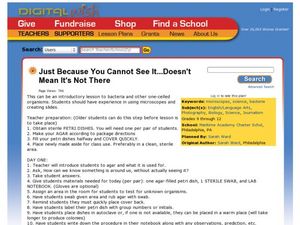Curated OER
Defining the Difference Between Prokaryotic and Eukaryotic Cells
Students examine microscopic life by conducting a scientific investigation. In this cell analysis lesson, students define the prokaryotic and eukaryotic cells and discuss their word origins. Students view each type of cell on slides...
Curated OER
Measuring Permeability of Soil, Sand and Gravel
Students investigate the different materials in their environment. In this geology lesson, students collaborate in groups to examine the differences in sand, soil and gravel. Students utilize a magnifying glass or microscope and record...
Curated OER
Just Because You Cannot See It... Doesn't Mean It's Not There
Students discover bacteria which is around them by using agar over three days. In this biology lesson, students predict what they will see over the three days and then take photographs of what is actually shown. Finally, students write...
Curated OER
Waterworks
Students investigate the water quality of a river. In this water quality lesson plan, students use microscopes, probing devices, and global positioning systems to determine water quality and create presentations on it.
Curated OER
What in the World..?!?
Students photograph mystery images. In this observation skills instructional activity, students gather everyday objects and place them under a digital microscope. They magnify the image and take a photograph of it. The image is then...
Curated OER
Living Creatures Up Close
Pupils study pond creatures. In this animal sciences lesson plan, students take a walking field trip to a local pond to collect small insects. Pupils study these insects under a microscope, conduct research on their insect, and create a...
Curated OER
What Does Life Look Like Under a Microscope?
Learners discover cells make up all living things. In this life science lesson plan, students investigate living organisms and the cells that create them. Finally the learners create a testable question, conduct an investigation, and...
Curated OER
Microscopes
In this microscopes worksheet, 7th graders read information about microscopes and how they work. Students then complete several questions about the passage. Students study the diagram of a microscope using the letter definitions.
Curated OER
Cell Theory, Scientists, & Cell Types
In this cells activity, students compare the characteristics of eukaryotic and prokaryotic cells. Students describe how different scientists contributed to the cell theory. This activity has 6 short answer questions and 1 graphic organizer.
Curated OER
Quiz Questions - Cells
In this cells instructional activity, students read and choose the multiple choice answers to 20 questions involving cells, microscopes, and the life process of Growth.
Curated OER
A View of the Cell
In this viewing of a cell instructional activity, students will read a paragraph about how microscopes work and will use a diagram of a light microscope to complete 2 short answer questions.
Curated OER
Cells: The Units of Life
In this cells worksheet, 9th graders identify and use a microscope to look at cells. They explain the purpose for a microscope and how to find the total magnifying power of a microscope. Students also determine what would cause an image...
Curated OER
Microscope Word Search
In this word search worksheet, students locate 12 words related microscopes. The word list includes ocular lens, and stage clips.
Curated OER
Microscope Parts Word Search Puzzle
In this language arts worksheet, students locate the names of 6 parts to a microscope in a word search puzzle. One of the words in the word bank is spelled wrong.
Curated OER
Diversity of Protists
Pupils identify under a microscope several different genera of protists. They discuss the three different categories of protists. Students discuss characteristics of the protists that they have already been taught. They view and...
Curated OER
Seeing Cells
Students discuss what comes to mind when they hear the term cell and discuss what a cell is in biological terms. They look at pictures of cells and color a picture of a cell diagram, writing the job of each part as they go. After the...
Curated OER
Time Lapse Seed Germination with the QX3 Intel Digital Microscope
Students use the time-lapse feature of the QX3 Intel Digital Microscope
to observe germination of seeds. They use the QX3 Intel Digital microscope to create time lapse video films of seed germination experiments.
Curated OER
Pond Life Identification Kit
Young scholars explore ecology and biodiversty. They use the wet-mount procedure to make several slides to view using the microscope and draw what they see.
Curated OER
The Microscopic World
Students identify magnification by first using a magnifying glass and then with photos taken through a microscope. They complete a handout that leads them through each activity stated. Finally, students use their microscope to view a...
Curated OER
Particle Depostition Lab
Middle schoolers collect, study and observe the pollution in our air. They list three kinds of pollution that they think is in our air. Students comprehend that the atmosphere is almost completely made up of invisible gaseous...
Curated OER
Underneath the Microscope
Eighth graders enhance their skills in operating a microscope. They become comfortable with the vocabulary associated with microscopes and investigate how to place slides and focus them properly using the microscope. Students are given...
Curated OER
Understanding Cells
Students identify and define several related vocabulary terms. Students complete a short lab and complete the questions. Students create a cell crossword puzzle and play cell computer games through the included links.
Curated OER
Microscopes
Students investigate how microscopes are used. They identify ways microscopes are used to see cells and in various careers. They complete activities involving creating a vocabulary book, crossword puzzles, designing posters, and...
Curated OER
Lesson Plan: The Cell- A Historical Perspective
Young scholars discover the impact the invention of the microscope had on scientific discovery as well as the concept of spontaneous generation and the cell theory. Students examine these scientific concepts through a WebQuest and by...

























